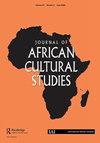从枪和钢铁到细菌:gon alo m丰达新雕塑中的疟疾碎屑
IF 0.9
2区 社会学
Q2 CULTURAL STUDIES
引用次数: 0
摘要
本文对莫桑比克著名艺术家gonalalo m丰达的作品进行了分析和理论分析,他以将废金属重新运用到引人注目的雕塑中而闻名。他以在组装中使用各种武器部件以及最近的工业废料而闻名。这篇文章将NGO Tchau Tchau Malaria(再见疟疾)的内部残留喷雾(IRS)运动中使用过的、剩余的和丢弃的物品带到他的作品中。这篇文章首先探讨了枪支废料(我称之为“战争废料”)和工业钢铁废料(“现代垃圾”)的作用,然后转向用根除疟疾的基础设施(我称之为“疟疾碎屑”)创作的雕塑的意义。通常人眼看不见的疟疾病原体,通过美国国税局的活动与之斗争。艺术可以以创新的方式使这种拯救生命的科学干预变得可见和可传播,并可以在传播消灭疟疾的科学方面发挥关键作用。本文章由计算机程序翻译,如有差异,请以英文原文为准。
From Guns and Steel to Germs: Malarial Detritus in New Sculptures by Gonçalo Mabunda
ABSTRACT This article analyses and theorises work by the celebrated Mozambican artist Gonçalo Mabunda, who is famed for his redeployment of scrap metal into striking sculptures. He is known for using various weapons components in his assemblages, as well as – more recently – industrial scrap items. This article considers the arrival of used, leftover and discarded items used in the Internal Residual Spray (IRS) campaign deployed by the NGO Tchau Tchau Malaria (Goodbye Malaria) into his works. The article first explores the role of waste from guns (what I term “war scrap”) and industrial steel (“modernity trash”), then turns to the significance of sculptures created with malaria-eradication infrastructure (what I term “malarial detritus”). The agents of malaria, usually invisible to the human eye, are combatted through IRS campaigns. Art can make this life-saving scientific intervention visible, and communicable, in innovative ways and can play a key role in communicating the science of malaria eradication.
求助全文
通过发布文献求助,成功后即可免费获取论文全文。
去求助
来源期刊

Journal of African Cultural Studies
Multiple-
CiteScore
1.70
自引率
10.00%
发文量
13
期刊介绍:
The Journal of African Cultural Studies publishes leading scholarship on African culture from inside and outside Africa, with a special commitment to Africa-based authors and to African languages. Our editorial policy encourages an interdisciplinary approach, involving humanities, including environmental humanities. The journal focuses on dimensions of African culture, performance arts, visual arts, music, cinema, the role of the media, the relationship between culture and power, as well as issues within such fields as popular culture in Africa, sociolinguistic topics of cultural interest, and culture and gender. We welcome in particular articles that show evidence of understanding life on the ground, and that demonstrate local knowledge and linguistic competence. We do not publish articles that offer mostly textual analyses of cultural products like novels and films, nor articles that are mostly historical or those based primarily on secondary (such as digital and library) sources. The journal has evolved from the journal African Languages and Cultures, founded in 1988 in the Department of the Languages and Cultures of Africa at the School of Oriental and African Studies, London. From 2019, it is published in association with the International African Institute, London. Journal of African Cultural Studies publishes original research articles. The journal also publishes an occasional Contemporary Conversations section, in which authors respond to current issues. The section has included reviews, interviews and invited response or position papers. We welcome proposals for future Contemporary Conversations themes.
 求助内容:
求助内容: 应助结果提醒方式:
应助结果提醒方式:


